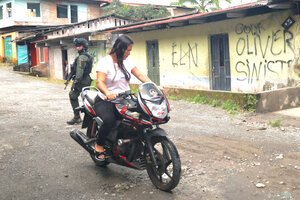Colombia’s disarming compassion
The government’s peace agenda seeks to include rebel factions in the work of ending conflict through a caring response to communities torn by violence.

A woman drives near a house displaying graffiti from the National Liberation Army (ELN) and the Oliver Sineterra front of the Revolutionary Armed Forces of Colombia (FARC) in Tumaco, Colombia.
Reuters
There were plenty of reasons to be skeptical last August when Gustavo Petro, a leftist economist and former member of a guerrilla movement, was sworn in as president of Colombia, pledging to achieve “total peace” after the country’s long history of violent domestic conflicts. Yet his maximal vision is now showing modest momentum.
On New Year’s Eve, the government announced a six-month cease-fire with five violent paramilitary groups. That agreement extends and broadens a unilateral truce by the largest such faction, the National Liberation Army (known by its Spanish acronym ELN), that started on Christmas Eve.
The suspension of conflict, which will be monitored by national and international observers, is evidence of an emerging consensus between the government and its primary armed foes that building a lasting peace starts with shared measures of compassion.
In a first round of talks last month, the government and ELN rebels agreed to coordinate “emergency care” in communities most afflicted by violence. The Petro administration has established nearly 200 “unified command posts” throughout the country, uniting local authorities and civil society organizations to address issues like land disputes and violence against women. Since Mr. Petro took office, the government and the ELN have released prisoners in reciprocal gestures of goodwill.
The goal is to “reverse the humanitarian tragedy in concrete terms,” said Otty Patiño, the government’s chief negotiator. His ELN counterpart, Pablo Beltrán, said, “The work we have is of reconciliation, of finding common points again, of building a nation of peace and equity.”
Cease-fires, of course, are no guarantee of peace. They can be broken or used as an opportunity to rearm. A previous Colombian government made ending hostilities the outcome rather than a precondition of its landmark 2016 peace accord that stopped five decades of conflict with the Revolutionary Armed Forces of Colombia, long the most potent guerrilla movement.
Mr. Petro’s peace efforts, however, have strong public support. An Invamer Poll in October found that more than two-thirds of Colombians support renewed talks with the ELN – which failed seven times under previous governments – and three-fourths back dialogue with rebel groups over military action. Mexico is set to host a second round of talks between the government and ELN later this month.
Beyond the five groups included in the cease-fire, at least 20 more have signaled their interest in participating in the government’s peace agenda. The United Nations estimates that as many as 10,000 militants are still engaged in at least six armed conflicts. The ELN’s reach is particularly broad, with as many as 5,000 members active in more than 180 municipalities.
The Norwegian Refugee Council estimates that violence has disrupted the free movement and economic activity of 2.6 million Colombians this year alone. Some 100,000 people lived in forced confinement under militia control.
“Peacebuilding takes a lot of time,” former President Juan Manuel Santos, who brokered the 2016 peace accords, told the International Center for Transitional Justice in 2020. “The most difficult part is to reconcile, to heal the wounds. ... The stars that guide you are the rights of the victims.”
As a new year starts, Colombia is one of a few conflict-ridden countries taking concrete steps toward peace. By drawing armed rivals into the shared work of caring for local communities, Mr. Petro is showing that peace is more than the absence of war.

